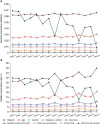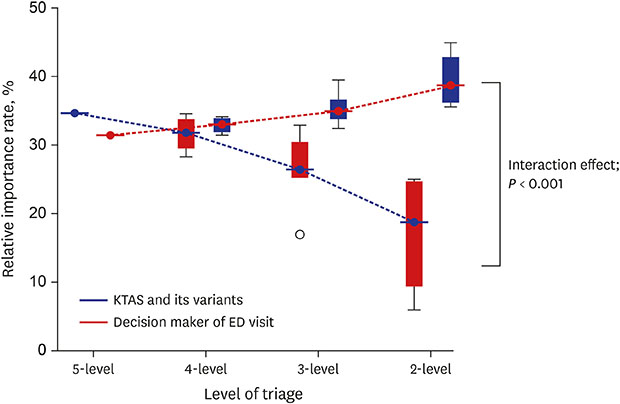INTRODUCTION
METHODS
Study design and settings
Data collection and management
Predictors
Table 1
KTAS and its levelling down through reconfiguring

Covariates
Primary outcome
Statistical analyses


RESULTS
Table 2
Results of adjusted analysis between KTAS original and emergency department disposition, using multinomial logistic regression analysis

 | Fig. 2Conditional dominance statistics of variables in model with the KTAS. After a total of 511 multinomial logistic regression models were constructed through a combination of the KTAS original and covariates, the conditional dominance statistics of each variable were derived from averaging the 9 within-order subsets (C1–C9) of their R2s. Overall, the values tended to decrease as the order placement rose. Among the variables, both the KTAS original and the decision maker of ED visit had more than twice as high values as the other variables.KTAS = Korean Triage and Acuity Scale, ED = emergency department.
|
 | Fig. 3General dominance and relative importance in various models with the KTAS and its variants. (A, B) General dominance statistics and relative importance rates for each variable in various models, which were constructed with covariates and the KTAS original and its variants. (A) The values of all covariates show a constant pattern regardless of the type of model; however, the KTAS was vulnerable to changes in the type of model (P < 0.001). (B) The values of the KTAS show the same pattern as (A), but the other variables show corresponding values as the number of the KTAS model increases (P < 0.001).KTAS = Korean Triage and Acuity Scale, ED = emergency department.
|
Table 3
General dominance statistics and relative importance rates for the Korean Triage and Acuity Scale and its variants

 | Fig. 4Relative importance of 2 major variables with decreasing number of triage levels. Comparing the 2 major variables with the highest relative importance rates, the value of the KTAS decreased correspondingly as the level number decreased while the decision maker of ED visit tended to increase as the number of triage levels decreased (P < 0.001).KTAS = Korean Triage and Acuity Scale, ED = emergency department.
|




 PDF
PDF Citation
Citation Print
Print







 XML Download
XML Download